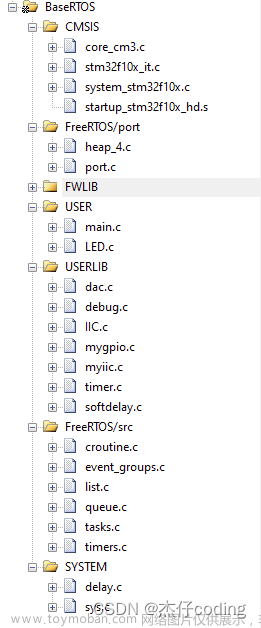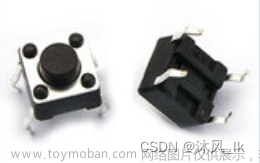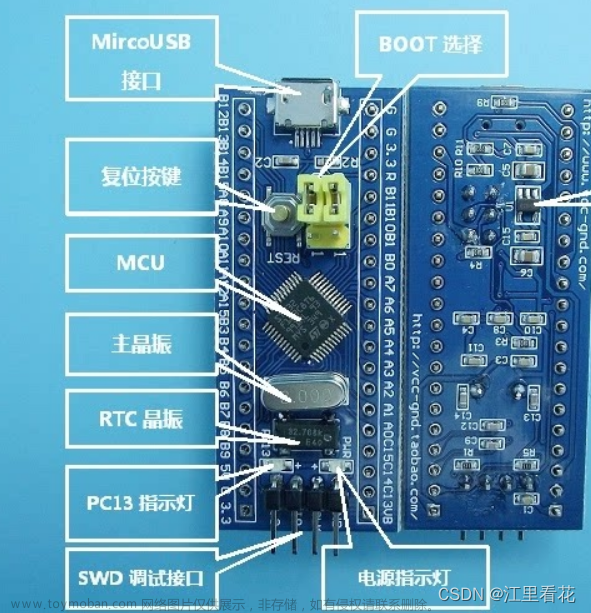一、按键控制原理图
按键:button
电阻:res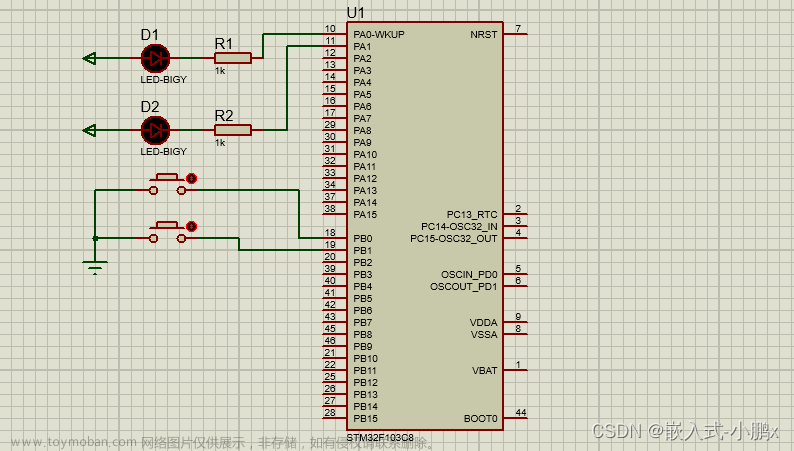
二、按键代码
1. led.c文件的代码
先配置LED灯的GPIO
//LED 初始化函数
void Led_Init(void){
//声明一个结构体,名字是GPIO_InitStructure
GPIO_InitTypeDef GPIO_InitStructure;
//使能GPIOA的时钟,ENABLE代表使能
RCC_APB2PeriphClockCmd(RCC_APB2Periph_GPIOA,ENABLE);//GPIOA
//设置引脚为推挽输出Out_PP
GPIO_InitStructure.GPIO_Mode=GPIO_Mode_Out_PP;
//定义引脚为 0号引脚 和 1号引脚
GPIO_InitStructure.GPIO_Pin=GPIO_Pin_0 | GPIO_Pin_1;
//设置引脚的速度50MHz
GPIO_InitStructure.GPIO_Speed=GPIO_Speed_50MHz;
//初始化GPIO,初始化哪个引脚就对应哪个
GPIO_Init(GPIOA,&GPIO_InitStructure);//初始化GPIOA,所以引脚对应PA0和PA1
//初始化时LED应为熄灭状态,所以要拉高LED引脚的电平
GPIO_SetBits(GPIOA,GPIO_Pin_0 | GPIO_Pin_1); //PA0 和 PA1引脚拉高电平
}
编写LED亮灭的函数
//LED灯状态函数
void Ledx_state(int x , int t){ //x表示第几个LED,t==1表示点亮,t==0表示熄灭
if(x==1){ //x==1对应LED1
if(t==1)GPIO_ResetBits(GPIOA,GPIO_Pin_0); //LED1点亮
if(t==0)GPIO_SetBits(GPIOA,GPIO_Pin_0); //LED1熄灭
}
if(x==2){ //x==2对应LED2
if(x==1)GPIO_ResetBits(GPIOA,GPIO_Pin_1); //LED2点亮
if(x==0)GPIO_SetBits(GPIOA,GPIO_Pin_1); //LED2熄灭
}
}
实现按下按键LED灯的状态取反
//***** 实现按下按键LED灯的状态取反 *****//
void Led1_Turn(void){
//如果PA0的输出寄存器的值为0,证明LED1为点亮状态
if(GPIO_ReadOutputDataBit(GPIOA , GPIO_Pin_0)==0){
//取反,PA0置高电平,LED1熄灭
GPIO_SetBits(GPIOA , GPIO_Pin_0);
}
else{ //PA0的输出寄存器的值为1,证明LED1为熄灭状态
//取反,PA0置低电平,LED1点亮
GPIO_ResetBits(GPIOA , GPIO_Pin_0);
}
}
void Led2_Turn(void){
//如果PA1的输出寄存器的值为0,证明LED2为点亮状态
if(GPIO_ReadOutputDataBit(GPIOA , GPIO_Pin_1)==0){
//取反,PA1置高电平,LED2熄灭
GPIO_SetBits(GPIOA , GPIO_Pin_1);
}
else{ //PA1的输出寄存器的值为1,证明LED2为熄灭状态
//取反,PA1置低电平,LED2点亮
GPIO_ResetBits(GPIOA , GPIO_Pin_1);
}
}
led.c总代码
#include "led.h"
#include "stm32f10x.h"
void Led_Init(void)
{
GPIO_InitTypeDef GPIO_InitStructure;
RCC_APB2PeriphClockCmd(RCC_APB2Periph_GPIOA,ENABLE);//GPIOA
GPIO_InitStructure.GPIO_Mode=GPIO_Mode_Out_PP;
GPIO_InitStructure.GPIO_Pin=GPIO_Pin_0|GPIO_Pin_1;
GPIO_InitStructure.GPIO_Speed=GPIO_Speed_50MHz;
GPIO_Init(GPIOA,&GPIO_InitStructure);
GPIO_SetBits(GPIOA,GPIO_Pin_0|GPIO_Pin_1);
}
//LED灯状态函数
void Ledx_state(int x , int t){ //x表示第几个LED,t==1表示点亮,t==0表示熄灭
if(x==1){
if(t==1)GPIO_ResetBits(GPIOA,GPIO_Pin_0);
if(t==0)GPIO_SetBits(GPIOA,GPIO_Pin_0);
}
if(x==2){
if(t==1)GPIO_ResetBits(GPIOA,GPIO_Pin_1);
if(t==0)GPIO_SetBits(GPIOA,GPIO_Pin_1);
}
}
//***** 实现按下按键LED灯的状态取反 *****//
void Led1_Turn(void){
//如果PA0的输出寄存器的值为0,证明LED1为点亮状态
if(GPIO_ReadOutputDataBit(GPIOA , GPIO_Pin_0)==0){
//取反,PA0置高电平,LED1熄灭
GPIO_SetBits(GPIOA , GPIO_Pin_0);
}
else{ //PA0的输出寄存器的值为1,证明LED1为熄灭状态
//取反,PA0置低电平,LED1点亮
GPIO_ResetBits(GPIOA , GPIO_Pin_0);
}
}
void Led2_Turn(void){
//如果PA1的输出寄存器的值为0,证明LED2为点亮状态
if(GPIO_ReadOutputDataBit(GPIOA , GPIO_Pin_1)==0){
//取反,PA1置高电平,LED2熄灭
GPIO_SetBits(GPIOA , GPIO_Pin_1);
}
else{ //PA1的输出寄存器的值为1,证明LED2为熄灭状态
//取反,PA1置低电平,LED2点亮
GPIO_ResetBits(GPIOA , GPIO_Pin_1);
}
}
2. led.h头文件的代码
#ifndef __LED_H
#define __LED_H
void Led_Init(void); //LED初始化
void Ledx_state(int i , int x); //LED灯状态函数
#endif
3. key.c文件的代码
先配置按键的GPIO
//按键 初始化函数
void Key_Init(void){
//声明一个结构体,名字是GPIO_InitStructure
GPIO_InitTypeDef GPIO_InitStructure;
//使能GPIOA的时钟,ENABLE代表使能
RCC_APB2PeriphClockCmd(RCC_APB2Periph_GPIOB,ENABLE);//GPIOB
//按键需要设置引脚模式为上拉模式GPIO_Mode_IPU
GPIO_InitStructure.GPIO_Mode=GPIO_Mode_IPU; //上拉模式GPIO_Mode_IPU
//定义引脚为 0号引脚 和 1号引脚
GPIO_InitStructure.GPIO_Pin=GPIO_Pin_0 | GPIO_Pin_1;
//设置引脚的速度50MHz
GPIO_InitStructure.GPIO_Speed=GPIO_Speed_50MHz;
//初始化GPIO,初始化哪个引脚就对应哪个
GPIO_Init(GPIOB,&GPIO_InitStructure);//初始化GPIOB,所以引脚对应PA0和PA1
//初始化时LED应为熄灭状态,所以要拉高LED引脚的电平
GPIO_SetBits(GPIOB,GPIO_Pin_0 | GPIO_Pin_1); //PB0 和 PB1引脚拉高电平
}
获取当前按键键值的函数
uint8_t Key_GetNum(void){ //获取当前按键键值
uint8_t KeyNum = 0;
//检测PB0引脚是否为低电平,按键按下时为低电平
if(GPIO_ReadInputDataBit(GPIOB , GPIO_Pin_0)==0){ //PB0为低电平,按键1已按下
delay_ms(20); //延时,消抖
//消抖,等待PB0重新变成高电平,如果一直为低电平则一直进入死循环
while(GPIO_ReadInputDataBit(GPIOB , GPIO_Pin_0)==0);
delay_ms(20); //延时,消抖
KeyNum=1; //键值赋值为1,代表按键1已按下
}
//检测PB1引脚是否为低电平,按键按下时为低电平
if(GPIO_ReadInputDataBit(GPIOB , GPIO_Pin_1)==0){ //PB1为低电平,按键2已按下
delay_ms(20); //延时,消抖
//消抖,等待PB1重新变成高电平,如果一直为低电平则一直进入死循环
while(GPIO_ReadInputDataBit(GPIOB , GPIO_Pin_1)==0);
delay_ms(20); //延时,消抖
KeyNum=2; //键值赋值为2,代表按键1已按下
}
return KeyNum; //返回键值
}
key.c总代码
#include "key.h"
void Key_Init(void){
GPIO_InitTypeDef GPIO_InitStructure;
RCC_APB2PeriphClockCmd(RCC_APB2Periph_GPIOB,ENABLE);//GPIOB
GPIO_InitStructure.GPIO_Mode = GPIO_Mode_IPU; //设置上拉模式 GPIO_Mode_IPU
GPIO_InitStructure.GPIO_Pin=GPIO_Pin_0|GPIO_Pin_1;
GPIO_InitStructure.GPIO_Speed=GPIO_Speed_50MHz;
GPIO_Init(GPIOB,&GPIO_InitStructure);
GPIO_SetBits(GPIOB,GPIO_Pin_0|GPIO_Pin_1);
}
uint8_t Key_GetNum(void){
uint8_t KeyNum = 0;
if(GPIO_ReadInputDataBit(GPIOB , GPIO_Pin_0)==0){
delay_ms(20);
while(GPIO_ReadInputDataBit(GPIOB , GPIO_Pin_0)==0);
delay_ms(20);
KeyNum=1;
}
if(GPIO_ReadInputDataBit(GPIOB , GPIO_Pin_1)==0){
delay_ms(20);
while(GPIO_ReadInputDataBit(GPIOB , GPIO_Pin_1)==0);
delay_ms(20);
KeyNum=2;
}
return KeyNum;
}
4. key.h头文件的代码
#ifndef __KEY_H
#define __KEY_
#include "stm32f10x.h" // Device header
#include "delay.h"
void Key_Init(void); //按键初始化
uint8_t Key_GetNum(void); //获取当前按键按下的键值
#endif
5. main.c文件的代码
5.1 按键按下实现LED亮或者灭
#include "stm32f10x.h"
#include "led.h"
#include "key.h"
#include "delay.h"
uint8_t KeyNum = 0;
int main(void)
{
delay_init();
Led_Init();
Key_Init();
while(1){
KeyNum = Key_GetNum(); //获取键值
if(KeyNum == 1){
//按下按键1,LED1灯亮,LED2灯灭
Ledx_state(1 , 1);
Ledx_state(2 , 0);
}
if(KeyNum == 2){
//按下按键2,LED2灯亮,LED1灯灭
Ledx_state(1 , 0);
Ledx_state(2 , 1);
}
}
仿真效果图: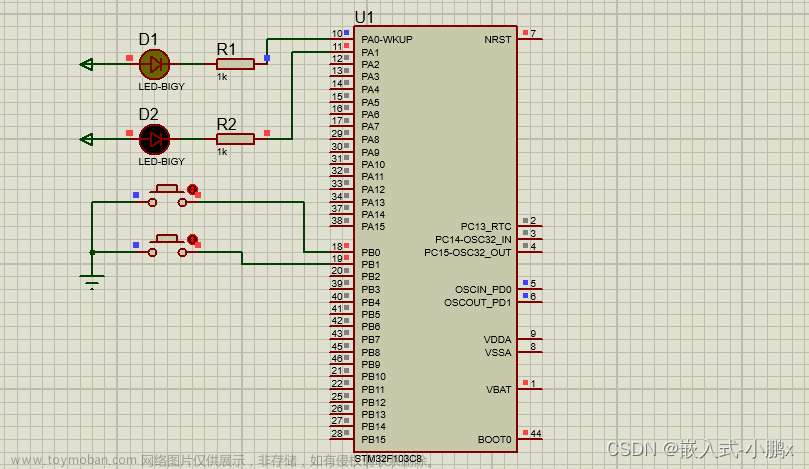
5.2 按键按下实现LED状态取反
#include "stm32f10x.h"
#include "led.h"
#include "key.h"
#include "delay.h"
uint8_t KeyNum = 0;
int main(void)
{
delay_init();
Led_Init();
Key_Init();
while(1){ //按下按键,LED灯取反
KeyNum = Key_GetNum(); //获取键值
if(KeyNum == 1){
Led1_Turn(); //按下按键1,LED1灯状态取反
}
if(KeyNum == 2){
Led2_Turn(); //按下按键2,LED2灯状态取反
}
}
仿真效果图: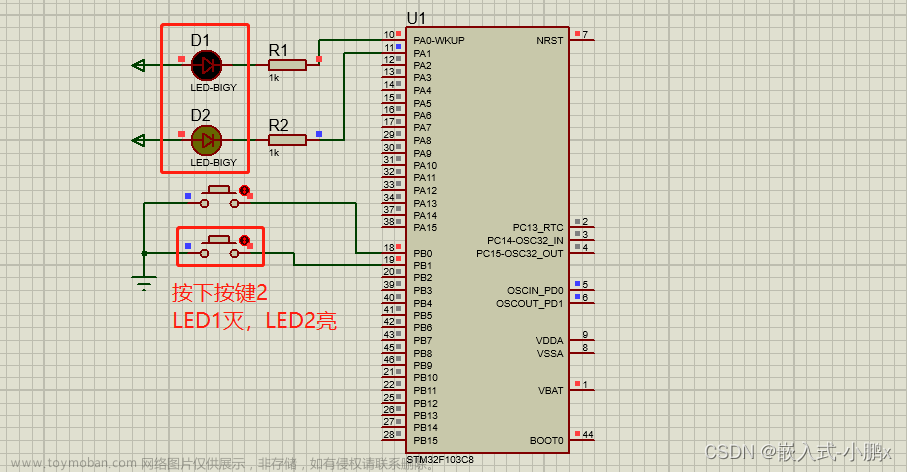 文章来源:https://www.toymoban.com/news/detail-728050.html
文章来源:https://www.toymoban.com/news/detail-728050.html
三、项目(代码+仿真)分享链接
百度网盘
链接:https://pan.baidu.com/s/1pcVtAcER2mAwnQnyRL3aXQ
提取码:p8q4文章来源地址https://www.toymoban.com/news/detail-728050.html
到了这里,关于Stm32f103c8t6(proteus仿真)学习——3.按键控制LED灯的文章就介绍完了。如果您还想了解更多内容,请在右上角搜索TOY模板网以前的文章或继续浏览下面的相关文章,希望大家以后多多支持TOY模板网!

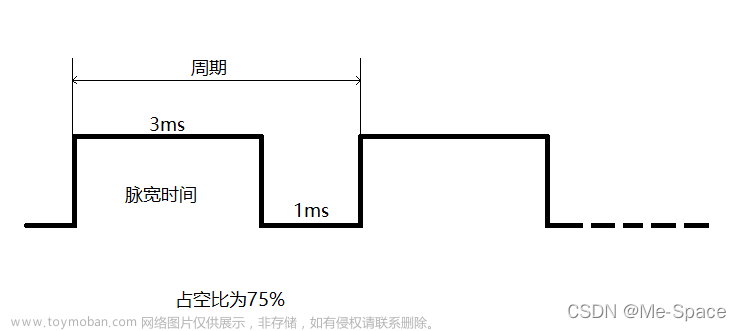

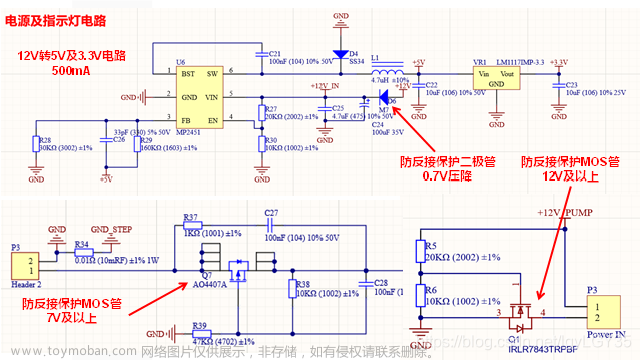
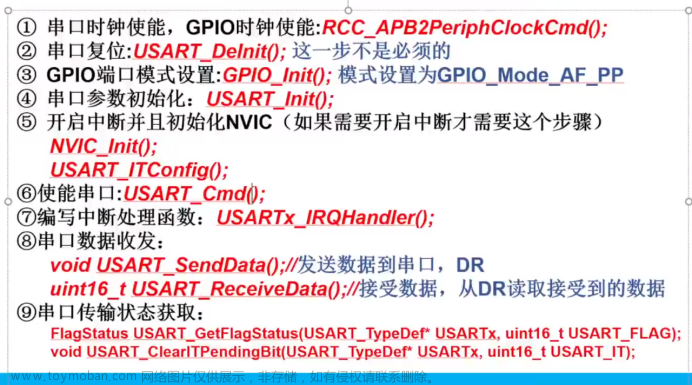
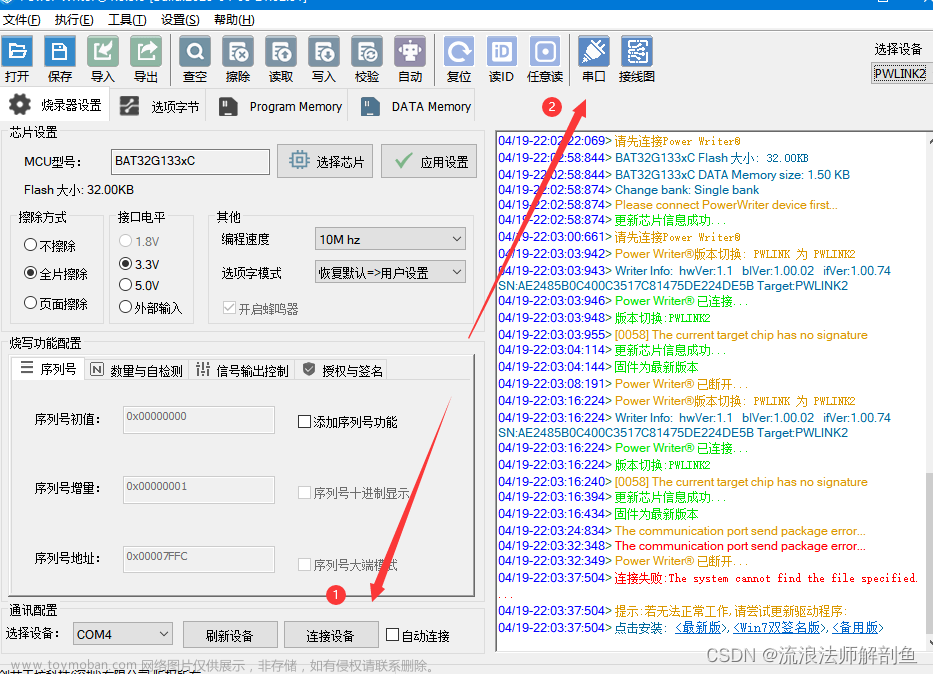
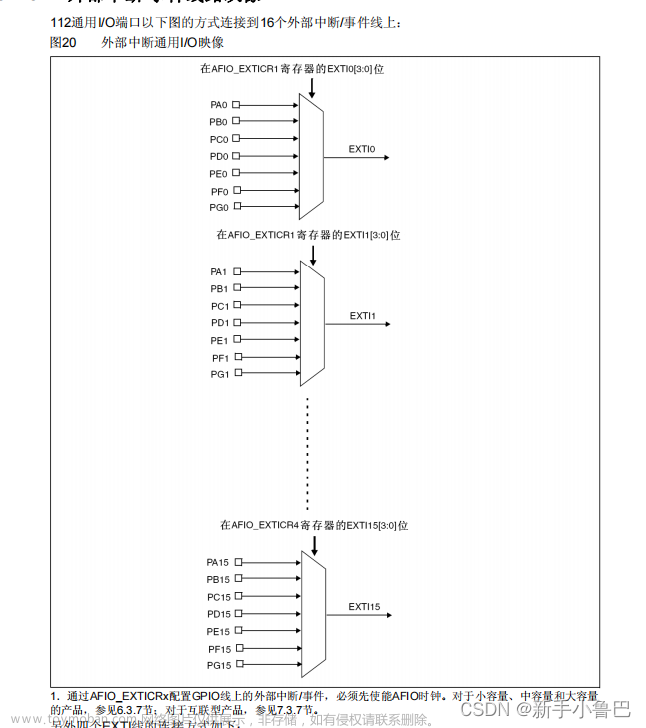
![[STM32F103C8T6]ADC转换](https://imgs.yssmx.com/Uploads/2024/02/458238-1.png)
